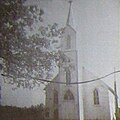Augsburg | |
|---|---|
| Coordinates: 35°24′52″N93°14′18″W / 35.41444°N 93.23833°W | |
| Country | United States |
| State | Arkansas |
| County | Pope County |
| Named after | Augsburg, Germany |
| Elevation | 646 ft (197 m) |
| GNIS feature ID | 57291 [1] |
Augsburg is an unincorporated community in Pope County, Arkansas, United States. [1]
Contents
In 1883, the first German-speaking Lutheran families began arriving in Pope County, 15 miles northwest of Russellville.
Augsburg was named for the German city of Augsburg. In 1884, they built their first church, Zion Lutheran Church. In 1907, it burned and a new one was built which also burned, in 1978, and replaced in 1979–80. Rev. F. W. Herzberger was the first Pastor and Rev. Joshua Ralston is the current Pastor.[ citation needed ]




